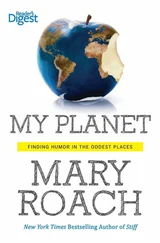Scott is a big guy, 6 feet 5 and not without some cushioning. He has young kids, and it is easy to picture him with them—on his lap, on his back, climbing him like a play structure. Though he has a background in waste management, he spent seven years elsewhere in NASA, plotting rocket trajectories. Eventually Weinstein realized he wanted to work with people. I imagine he’s very good at what he does. His genial, matter-of-fact nature makes it easy to sit down with him and have a talk about things one doesn’t routinely talk about.
That is more important than you think. Zero-gravity excretion is not entirely a joking matter. The simple act of urination can, without gravity, become a medical emergency requiring catheterization and embarrassing radio consults with flight surgeons. “The urge to go is different in space,” says Weinstein. There is no early warning system as there is on Earth. Gravity causes liquid waste to accumulate on the floor of the bladder. As the bladder fills, stretch receptors are stimulated, alerting the bladder’s owner to the growing volume and delivering an incrementally more insistent signal to go. In zero gravity, the urine doesn’t collect at the bottom of the bladder. Surface tension causes it to adhere to the walls all around the organ. Only when the bladder is almost completely full do the sides begin to stretch and trigger the urge. And by then the bladder may be so full that it’s pressing the urethra shut. Weinstein counsels astronauts to schedule regular toilet visits even if they don’t feel the urge. “And it’s the same with BMs,” he adds. “You don’t get that same sensation.”
Broyan and Weinstein have offered to let me try the Positional Trainer. Weinstein reaches over to the wall and flips a switch that illuminates the inside of the bowl. Because once you sit down, you are blocking the light from the ceiling fixtures. “So,” says Weinstein. “You’re going to try to align yourself, flip on the light, see how you did.”
I ask him whether the astronauts are observing while they go, or before they start.
Broyan appears quietly stricken. “You can’t defecate on that toilet.” He glances at Weinstein, the briefest of glances yet unmistakable in its message: Oh my god oh my god she was gonna crap on the camera.
I wasn’t, honestly.
Weinstein, ever genial: “Well, technically you can , but then Crew Systems has to come in and clean it up.”
“It’s not a working toilet, Mary,” says Broyan, just to be sure I’m clear.
It has happened just once, a hit-and-run. “It was before my time,” says Weinstein. “If I’d been here, I’d have been pulling security tapes.” He wishes me good luck. The two of them leave and shut the door.
Imagine stumbling upon an especially rank porno channel, and then realizing it’s you on screen. My brain elects to reinterpret the image: See the funny puppet? Watch his mouth. What’s he saying? He’s saying, “Ooooo-aaaah-oooooo.”
When Weinstein and Broyan return, Weinstein says he doubts that many of the astronauts use the potty cam. “I get the sense most of them don’t want to see themselves.” Weinstein provides an alternate positioning tactic, “the two-joint method.” The distance between the anus and the front of the seat should equal the distance between the tip of the middle finger and its big knuckle.
Along the same wall as the Positional Trainer is a fully appointed and functioning Space Shuttle commode. It looks less like a toilet than a high-tech, top-loading washing machine. Though the device itself is a high-fidelity version of the one on board the shuttle, the experience is not. There is gravity down here at Johnson Space Center, and that makes all the difference. Gravity facilitates what is known in aerospace waste collection circles as “separation.” In weightlessness, fecal matter never becomes heavy enough to break away and drop down and venture forth on its own. The space toilet’s air flow is more than an alternate flushing method. It facilitates the Holy Grail of zero-gravity elimination: good separation. Air drag serves to pull the material away from its source.
A separation strategy courtesy of Weinstein: spread the cheeks. That way, there is less contact between the body and the “bolus” (another in the waste engineer’s vast arsenal of euphemisms)—and therefore less surface tension to be broken. The newest seat is designed to function as a “cheek spreader” to facilitate a cleaner break.
A more sensible arrangement might be to adopt the posture favored by much of the rest of the world—and by the human excretory system itself. “The squat tends to spread the cheeks,” says Don Rethke, a senior engineer at Hamilton Sundstrand, the contractor on many of the NASA waste collection systems over the years. Rethke suggested to NASA that they add a set of foot restraints higher up, to accommodate those who wish to approximate the squatting posture in zero gravity. No go. When it comes to the astronauts’ creature comforts, familiarity wins out over practicality. A kitchen table makes little sense without gravity, but all long-duration spacecraft have them. Crews want to sit around the kitchen table at the end of the day to eat and talk and feel normal and forget for a moment that they’re hurtling utterly alone through the blackness of a deadly vacuum. In the aftermath of Apollo, where there were fecal bags rather than toilets, bathroom facilities became a charged topic. “When the astronauts came back, they physically and psychologically wanted a sit-down commode,” says Rethke.
Understandable. The fecal bag is a clear plastic sack, similar to a vomit bag in its size, holding capacity, and ability to inspire dread and revulsion. [84] Still, it could have been worse. Also under consideration for the Apollo crews: the “defecation glove.” Here the astronaut would reach around and crap in his own palm, then peel back the glove, much as dog owners use a plastic newspaper sleeve to pick up and dispose of dog feces. Then there was the Chinese Finger, a bag that would clamp onto a bolus as you pulled on the end. The name Chinese Finger refers to the cheap party toy of the same name—and possibly to the astronaut’s response to the device.
A molded adhesive ring at the top of the bag was designed for the average curvature of an astronaut’s cheeks. It rarely fit. The adhesive pulled hairs. Worse, without gravity or air flow or anything else to foster separation, the astronaut was obliged to employ his finger. Each bag had a small inset pocket near the top, called a “finger cot.”
The fun didn’t stop there. Before he could roll up and seal the bag to trap the offending monster, the crew member was further burdened with tearing open a small packet of germicide, squeezing the contents into the bag, and manually kneading the germicide through the feces. Failure to do so would allow fecal bacteria to do their bacterial thing, digesting the waste and expelling the gas that, inside your gut, would become your own gas. Since a sealed plastic fecal bag cannot fart, it could, without the germicide, eventually burst. “The test of a good friend was to hand the bag to your crewmate and have him get that germicide completely mushed in with the fecal material,” Gemini and Apollo astronaut Jim Lovell told me. “I’d go, ‘Here, Frank, I’m busy.’”
Given the complexity of the chore, “escapees,” as free-floating fecal material is known in astronautical circles, plagued the crews. Below is an excerpt from the Apollo 10 mission transcript, starring Mission Commander Thomas Stafford, Lunar Module Pilot Gene Cernan, and Command Module Pilot John Young, orbiting the moon 200,000-plus miles from the nearest bathroom.
CERNAN: …You know once you get out of lunar orbit, you can do a lot of things. You can power down…And what’s happening is—
Читать дальше












